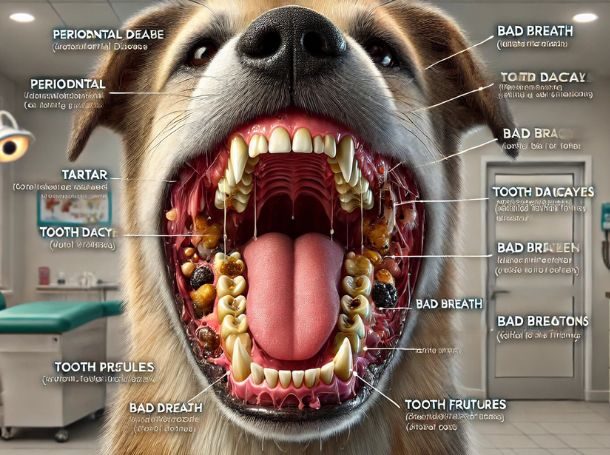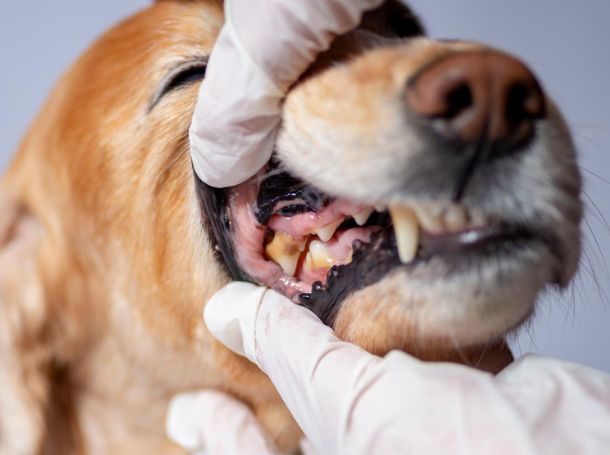
Canine Dental Care: Simple Tips for Healthy Teeth
- February 21, 2025
Table of Contents
Good oral hygiene isn’t just important for humans; it’s also vital for your dog’s overall health and well-being. Canine dental care is often overlooked, but it plays a crucial role in ensuring that your dog remains healthy, happy, and free from dental diseases. In this detailed guide, we’ll delve into the significance of canine dental care, common dental problems in dogs, how to care for your dog’s teeth, and the long-term benefits of maintaining a good oral hygiene routine for your furry friend.
Why Canine Dental Care Matters?
Dental health is just as important for dogs as it is for humans. Poor oral hygiene in dogs can lead to painful and expensive dental issues that affect their quality of life. Just like in people, dental problems in dogs, such as tartar buildup, plaque, and gum disease, can lead to more serious health complications if left untreated.
Many of the bacteria from an infected mouth can spread to other parts of the body, including the heart, kidneys, and liver. Additionally, untreated dental diseases can lead to tooth loss, bad breath, and eating difficulties. These are just a few reasons why it’s important to prioritize your dog’s dental care.
Common Canine Dental Problems

Dogs, like humans, are prone to a variety of dental issues. Here are some of the most common dental problems that dogs face:
Periodontal Disease: This is the most common dental problem in dogs and can affect 80% of dogs by the age of three. Periodontal disease is caused by plaque buildup that turns into tartar, leading to inflammation of the gums (gingivitis). If left untreated, it can progress to periodontitis, which can damage the bone supporting the teeth.
Plaque and Tartar Buildup: Plaque is a sticky film of bacteria that forms on your dog’s teeth. Over time, plaque hardens into tartar, which is much harder to remove. Plaque and tartar buildup are the primary causes of gum disease and tooth decay.
Tooth Decay and Cavities: Though less common in dogs than in humans, tooth decay can still occur, particularly if a dog consumes sugary foods or if there’s an issue with their saliva composition.
Bad Breath (Halitosis): Bad breath in dogs is often a sign of dental disease, particularly periodontal disease. While dogs naturally have a distinct odor, persistent bad breath should be addressed.
Tooth Fractures and Wear: Dogs that chew on hard objects (like bones, stones, or sticks) can fracture their teeth, which may lead to pain, infection, and tooth loss.
Oral Tumors: Though less common, tumors in a dog’s mouth can develop and interfere with their ability to chew or eat. These tumors can be benign or malignant and may require surgical removal.
Signs Your Dog Needs Dental Care
Recognizing the signs of dental problems in dogs can help you take early action to prevent severe health issues. Here are some common signs that your dog may need dental attention:
- Bad Breath: Foul-smelling breath is often a sign of plaque buildup or gum disease.
- Excessive Drooling: If your dog is drooling more than usual, it could indicate discomfort or dental pain.
- Difficulty Eating or Chewing: If your dog has trouble chewing or seems to avoid eating certain foods, it may have a tooth problem.
- Swollen or Bleeding Gums: Inflamed or bleeding gums are a clear indication of gum disease.
- Visible Tartar or Plaque: Yellowish or brownish deposits on your dog’s teeth are signs of tartar buildup.
- Pawing at the Mouth or Face: Dogs may paw at their face or mouth if they’re experiencing oral discomfort.
How to Maintain Your Dog’s Oral Hygiene?

Now that we know why canine dental care is so important, let’s explore the practical steps you can take to maintain your dog’s oral hygiene.
1. Regular Brushing
Brushing your dog’s teeth is the most effective way to prevent plaque and tartar buildup. Ideally, you should brush your dog’s teeth at least 2-3 times a week, but daily brushing is even better. Use a toothbrush and toothpaste specifically designed for dogs—never use human toothpaste, as it can be toxic to dogs.
Here’s how to brush your dog’s teeth:
- Step 1: Get your dog comfortable with the idea of tooth brushing by gently handling their mouth and gums first.
- Step 2: Apply a small amount of dog-friendly toothpaste to the toothbrush.
- Step 3: Start brushing slowly, focusing on the outer surfaces of your dog’s teeth. Be gentle around the gum line.
- Step 4: Praise and reward your dog after each brushing session to make it a positive experience.
2. Dental Chews and Toys
Dental chews and toyscan help reduce plaque and tartar buildup by providing friction against your dog’s teeth. Look for products that are designed specifically to clean teeth and massage gums. Ensure that the chews are suitable for your dog’s size and chewing habits. Some popular options include rawhide chews, rubber dental toys, and dental sticks.
3. Professional Dental Cleanings
Just like humans, dogs need professional dental cleanings from time to time. A veterinarian will use special tools to clean your dog’s teeth and remove tartar buildup, which can’t be effectively cleaned with a toothbrush. Professional cleanings are often done under anesthesia to ensure your dog is comfortable and safe during the procedure.
4. Regular Vet Checkups
During regular vet visits, your veterinarian will check your dog’s oral health. It’s important to have your dog’s teeth checked at least once a year for signs of dental problems. Early detection of issues such as gum disease, tooth decay, or oral tumors can help prevent more severe complications down the road.
5. Diet and Oral Health
What your dog eats can affect their oral health. Some pet food brands offer specially formulated kibble that helps reduce plaque buildup. You can also try adding fresh, crunchy vegetables like carrots or apples to your dog’s diet, as they can help clean teeth naturally.
6. Water Additives and Oral Sprays
Some water additives and oral sprays are designed to reduce plaque and freshen your dog’s breath. These products are often used in conjunction with other dental care practices but can be a helpful addition to your dog’s routine.
Long-Term Benefits of Canine Dental Care
Maintaining good dental care for your dog offers a variety of long-term benefits:
- Prevention of Pain and Discomfort: Regular dental care helps prevent the pain and discomfort that can arise from tooth decay or gum disease.
- Improved Overall Health: Oral health is directly linked to overall health. Preventing dental diseases can reduce the risk of heart disease, kidney problems, and other serious health issues.
- Better Quality of Life: A dog with healthy teeth is more likely to be energetic, eat comfortably, and engage in playful activities without discomfort.
- Cost Savings: Preventative care is always more cost-effective than treating advanced dental issues. Regular brushing and vet checkups can save you from expensive treatments down the road.
Conclusion
Canine dental care is a vital aspect of your dog’s overall health that should not be overlooked. By establishing a regular oral hygiene routine, providing appropriate chew toys, and seeking professional dental care when necessary, you can ensure that your dog enjoys a happy and healthy life. Early intervention and consistent care are key to preventing dental problems and protecting your dog from serious health conditions.
Make dental care a priority, and your dog will thank you with a healthy, vibrant smile for years to come!
Frequently Asked Questions
1. Why is dental care important for my dog?
Dental care is crucial for dogs because poor oral hygiene can lead to serious health problems like gum disease, tooth loss, and systemic infections that affect organs such as the heart, kidneys, and liver. Regular dental care ensures your dog stays happy and healthy for years to come.
2. How often should I brush my dog’s teeth?
Ideally, you should brush your dog’s teeth every day, but at a minimum, aim for 2-3 times a week. Regular brushing prevents plaque buildup, which can turn into tartar and lead to gum disease. Brushing daily helps maintain optimal oral hygiene.
3. Can I use human toothpaste to brush my dog’s teeth?
No, you should never use human toothpaste for dogs. Human toothpaste contains fluoride, which is toxic to dogs if swallowed. Always use dog-specific toothpaste, which is safe for them to ingest and designed to be effective in cleaning their teeth.
4. What are the signs of dental problems in dogs?
Some common signs that your dog might have dental problems include bad breath, difficulty eating, excessive drooling, pawing at the mouth, visible tartar or plaque, and swollen or bleeding gums. If you notice any of these signs, it’s essential to consult with your veterinarian.
5. Is it normal for my dog to have bad breath?
While some mild odor is normal, persistent bad breath (halitosis) is often a sign of underlying dental issues like periodontal disease. If your dog’s breath smells foul, it’s best to schedule a vet checkup.




Leave a comment